VMworld US 2016 Buzz: An Industry Roadmap: From storage to data management – STO7903
Adding some more colour to the highlights from my VMworld US 2016 coverage:
- VMworld US 2016: The Day 0 Buzz
- VMworld US 2016: The Day 1 Buzz
- VMworld US 2016: The Day 2 Buzz
- VMworld US 2016: The Day 3 Buzz
- VMworld US 2016: The Day 4 Buzz
Next up to another storage session with one of the fathers of VSAN, Christos Karamanolis, who is also a VMware Fellow, I’ve heard Christos speak a number of times and he’s very much worth listening to.
Christos started reiterating that data provides tremendous business value potential with a huge uptick in the amount of data stored.
Storage is not going to traditional storage arrays, analysts say disk arrays are rapidly declining compared to the amount of data produced. This is due to the rise of Software Defined Storage, either via hyperscale server SAN storage or enterprise server SAN storage.
Data is also becoming more mobile in a hybrid cloud world which is an IT nightmare, CIOs have no idea what data goes to AWS/Azure.
Today’s storage products do not meet the requirements of the evolving IT industry, HCI overcomes legacy limitations with a seamlessly integrated architecture.
Christos talked about Data LifeCycle Management.
Storage products currently come with data service tightly coupled with physical infrastructure, things such as snapshots/clones, replication, duplication, checksums, encryption etc. cannot be used across hybrid IT infrastructure and often can’t be done on an individual VM level.
He says it doesn’t have to be this way, we need to decouple data services from physical boundaries.
VMware already does this with vSphere Replication which is storage agnostic. Layer on SRM and you can coordinate your DR at scale with different storage hardware.
He went through what he called “The Data Storage Disrupters”:
- Public clouds with cost effective archival storage and a range of availability options. They don’t meet all requirements for enterprise primary storage but can be used for DR to the cloud. This is what vCloud Air / Network DRaaS is which is the most revenue generating part of the vCloud Air Network. You can also do DR between public clouds, he showed a demo
- New compute consumption models with pay as you go infrastructure and software as a service with data escaping the boundaries of IT org.
Portable Snapshots
He then said what about a long term idea, the portable snapshot, imagine if they could be decoupled from storage, could be mobile cross physical locations, archived anywhere, recovered anywhere. You can have local snapshots, replicas on-prem for analytics and remote copies for DR or archive. VMware is working on building this so you can even copy VM snapshots to AWS / Google.
This means you can take an existing VM, back it up to AWS, VMware will handle the data conversion. You could store it on Glacier cheaply. You could then restore that data either on-prem or even into S3, convert the data again and here’s the kicker, power it on as an EC2 instance! That’s cloud portability. Cross cloud VM migration, add that to NSX with cross cloud networking and you could create a number of interesting solutions for your vSphere VMs. Let me repeat, VMware is working on migrating VMs to AWS/Azure not just for a file backup but to actually convert them and run them natively.
Now to do this at scale, we need data lifecycle management all driven by policy across locations/storage. We need a global catalogue of data, diverse recovery worklows, with granular recovery for nearline, offline and DR.
Exoclones
Then Christos went on to talk about a distributed file system for cloud native apps, called VFS which would sit on top of VSAN and provide a file system that could massively scale.
The portable snapshot functionality would be there to for example be able to better dedupe and manage container images. This is called Exoclones. If you are refreshing thousands of containers in multiple sites, currently you can’t do block level differential updates, Exoclones would give this to you. You can also use Exoclones to do rapid copies of Big Data, Christos did a demo of just this.
I had previously seem some slides at the Office of the CTO booth in the Solutions Exchange, so this now made a bit more sense.
Data Governance
Christos closed with covering data governance, how do you track and control all that data, it is going to be a nightmare when it can be in so many places.
He sees a future soon with other decoupled data services which will be in software and portable:
- end to end data integrity: checksums
- space efficiency: dedupe / compression
- multi-tenancy: access control, isolation
- security: encryption, attribution
I had head Christos speak previously on how VSAN was architected to be a common storage platform for any number of things, from VMs, to native file/object services and also persistent storage for containers but this was so much more.
I’ve been impressed with how well VSAN has been developing into a credible storage platform, in fact lets just say platform that happens to store stuff. Sure, as a pure HCI SAN it is missing some functionality and its easy to poke holes into any product but I do believe the VSAN design is a solid idea and they are really thinking about future flexibility and reinventing storage as we know it.
Integrating the policy based management from the beginning elevated it from just another VSA for VMs and seeing the ideas today shows how important it will be when we consider future scale.
This session together with the previous VSAN futures session opened my eyes to many more possibilities, well done VSAN team!
As VMworld2016 has made the recording publicly available, you can view the session here:
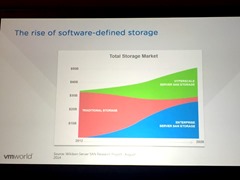
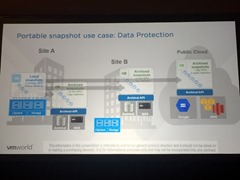
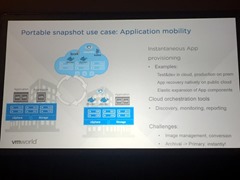
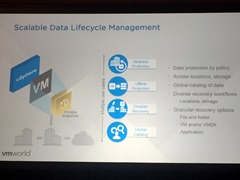
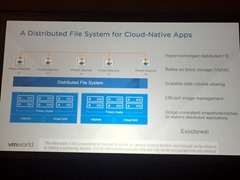
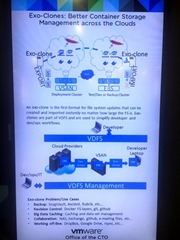
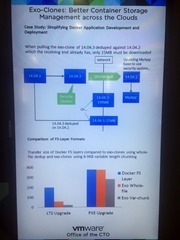
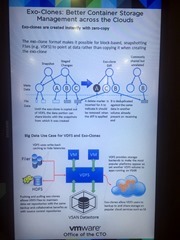
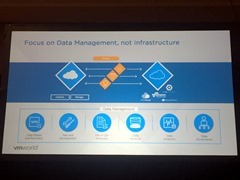


Recent Comments